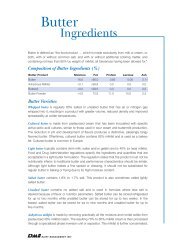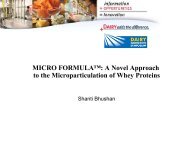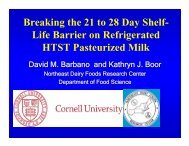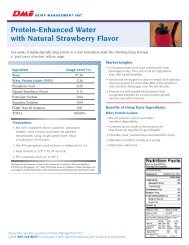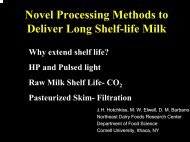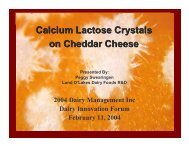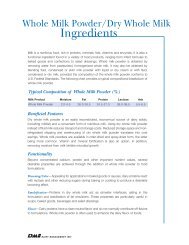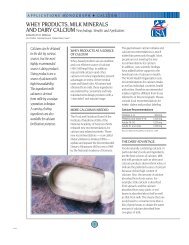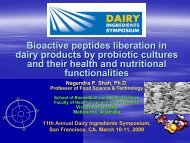Whey Protein Characteristics - InnovateWithDairy.com
Whey Protein Characteristics - InnovateWithDairy.com
Whey Protein Characteristics - InnovateWithDairy.com
Create successful ePaper yourself
Turn your PDF publications into a flip-book with our unique Google optimized e-Paper software.
®<br />
Technical Report:<br />
<strong>Whey</strong> <strong>Protein</strong> Heat Stability<br />
Written by: Kimberlee (K.J.) Burrington<br />
Reviewed by: Shantanu Agarwal<br />
As part of a growing health and wellness trend, food and beverage manufacturers are boosting the protein content of<br />
products. Many food and beverage manufacturers use whey proteins as the protein source of choice for product innovation.<br />
Expanded utilization of these ingredients holds great potential for creating even more new formulation possibilities through<br />
improvements in whey quality and performance.<br />
This report summarizes recent research on improving the heat stability of whey protein ingredients, thus helping product<br />
developers utilize them in more applications. <strong>Whey</strong>, by definition from the Code of Federal Regulations, is the liquid substance<br />
obtained by separating the coagulum from milk or cream in cheese making. <strong>Whey</strong> proteins represent about 20 percent of<br />
the milk proteins, which remain in the serum phase during the process of making cheese and are later processed into many<br />
different ingredients. The primary whey proteins are beta-lactoglobulin (β-lg), alpha-lactalbumin (α-lac), bovine serum albumin,<br />
immunoglobulins and proteose peptones. 1<br />
A unique set of proteins with special physical properties, whey proteins are a <strong>com</strong>ponent of many <strong>com</strong>mercial ingredient<br />
blends that contribute to the flavor, texture and nutrition of a wide variety of food products. The high level of essential amino<br />
acids, especially branched-chain amino acids, makes whey protein a sought-after nutritional ingredient. The physical<br />
properties of whey protein ingredients give them versatility across many food applications. One specific aspect of whey protein<br />
that may be challenging for some formulations is sensitivity to heat. Consequently, the Dairy Research Institute ® , established<br />
under the leadership of America’s dairy farmers through the dairy checkoff program, has supported a variety of research that<br />
aims to improve whey protein’s performance in higher heat processing.<br />
<strong>Whey</strong> <strong>Protein</strong> <strong>Characteristics</strong><br />
<strong>Whey</strong> <strong>Protein</strong> Ingredient Composition<br />
<strong>Whey</strong> protein ingredients include whey protein concentrates (WPC) and whey protein isolates (WPI), which typically range in<br />
protein from 25 to 90 percent protein. 2 Beta-lactoglobulin and α-lactalbumin are the predominant whey proteins, representing<br />
up to 70 percent of the total protein (Table 1). The characteristics of these two proteins account for many of the physical<br />
properties of whey protein ingredients.<br />
Table 1. <strong>Whey</strong> <strong>Protein</strong> Composition 2<br />
<strong>Whey</strong> <strong>Protein</strong> WPC % WPI %<br />
α-lactalbumin 12 to 16 14 to 15<br />
β-lactoglobulin 50 to 60 44 to 69<br />
Gly<strong>com</strong>acropeptide (GMP) 15 to 21 2 to 20<br />
Serum albumin 3 to 5 1 to 3<br />
Immunoglobulins 5 to 8 2 to 3<br />
Lactoferrin
Technical Report:<br />
<strong>Whey</strong> <strong>Protein</strong> Heat Stability<br />
<strong>Whey</strong> <strong>Protein</strong> Functionality<br />
<strong>Whey</strong> protein ingredients are multifunctional ingredients providing properties such as gelation, water binding, solubility,<br />
foaming, viscosity and emulsification for foods. Of all the functional properties, solubility is thought to be one of the<br />
most important because good solubility is a necessity for all of the other functional properties. <strong>Protein</strong> functionality<br />
is demonstrated through interactions between protein molecules and the solvent (water), salts (ions) and other food<br />
<strong>com</strong>ponents. 3 One of the unique properties of whey protein is good solubility in water over a wide range of pH (from<br />
pH 2 to 9), which is important for many beverage applications. 4 One challenge for whey protein is maintaining solubility<br />
during heat processing. Most foods are heat processed in some way, and whey proteins are susceptible to changes<br />
during heating, such as denaturation.<br />
Understanding Heat Stability and Denaturation<br />
Heat stability is the ability of proteins to survive heat processing without detrimental changes such as excessive turbidity,<br />
increased viscosity, phase separation, or precipitation or gelation. Beta-lactoglublin and α-lactalbumin are the major<br />
whey proteins responsible for the heat stability characteristics of ingredients such as WPC and WPI. 4 Heat denaturation<br />
of whey protein involves the unfolding of the protein followed by aggregation, which includes protein-protein interactions<br />
that are covalent (not reversible) and noncovalent (possibly reversible). 5<br />
One example of covalent interactions is the formation of disulfide bonds between two molelcules of β-lg. This can result from<br />
sulfhydryl oxidation or sulfhydryl-disulfide interchange. Thermal aggregation of whey protein is influenced by the temperature,<br />
ionic strength (salt concentration), ionic source and pH of the protein solution. Depending on these conditions, the proteins<br />
will show varying degrees and types of aggregate formation. In general, large, dense aggregates increase solution turbidity,<br />
whereas smaller and more linear aggregates can have a large effect on solution viscosity with minimal increase in turbidity.<br />
If the protein concentration is high enough, these protein aggregates will form either a turbid or a transparent gel network. 6<br />
<strong>Protein</strong> aggregation increases in the presence of salt (e.g., divalent salts such as calcium chloride cause increased protein<br />
aggregation when <strong>com</strong>pared to monovalent salts such as sodium chloride). The salt increases aggregation by either<br />
decreasing inter-protein charge repulsion (which is similar to the idea of bringing together the north poles of two magnets)<br />
or forming salt bridges between proteins. Because both mechanisms involve the electrostatic charge on protein molecules,<br />
it is modified at different levels of pH. The aggregation of whey proteins occurs readily in the pH range of 4.8 to 5.3, which is<br />
the range for β-lg and α-lac isoelectric points. The electrostatic interactions can be explained according to the relationship<br />
between net charge of β-lg and pH (Figure 1).<br />
Figure 1.<br />
30.00<br />
Polypeptide Charge Calculation for Beta-lactoglobulin<br />
Net Charge<br />
20.00<br />
10.00<br />
0.00<br />
-10.00<br />
-20.00<br />
-30.00<br />
1 2 3 4 5 6 7 8 9 10 11 12 13 14<br />
-40.00<br />
Adapted from K. Higgs and G. Rhodes 7<br />
pH<br />
3<br />
Xiong YL. Influence of pH and Ionic Envirnoment on Thermal Aggregation of <strong>Whey</strong> <strong>Protein</strong>s. J Agric Food Chem. 1992;40:380-384.<br />
4<br />
Vardhanabhuti B, Foegeding EA. Effects of dextran sulfate, NaCl, and initial protein concentration on thermal stability of β-lactoglobulin and α-lactalbumin at neutral pH. Food<br />
Hydrocolloids. 2008;22(5):752-762.<br />
5<br />
Ryan KN, Vardhanabhuti B, Jaramillo DP, van Zanten JH, Coupland JN, Foegeding EA. Stability and mechanism of whey protein soluble aggregates thermally treated with salts. Food<br />
Hydrocolloids. 2012;27:411-420.<br />
6<br />
Prabakaran S, Damodaran, S. Thermal unfolding of β-lactoglobulin: Characterization of initial unfolding events responsible for heat-induced aggregation.<br />
J Agric Food Chem. 1997;45:4303-4308.<br />
7<br />
Adapted from Polypetide Charge Calculation for Beta-lactoglbulin chart developed by Gale Rhodes, University of Southern Maine. Available at<br />
spdbv.vital-it.ch/TheMolecularLevel/Goodies/PeptChg.xls. Accessed April 19, 2012.<br />
e3.11.1 2
Most of the foods we consume are between pH 3 and 7. At pH 3, β-lg has a very high net positive charge, which means the<br />
proteins in the solution will have a lot of repulsive forces between them. These repulsive forces will inhibit interactions between<br />
proteins, even when heat is applied — so heat stability and clarity (lack of turbidity) even at protein concentrations of 7 percent<br />
protein is high. Once the pH is increased to 4, the net charge is decreased, as is the repulsion. The whey protein solution will<br />
now increase in turbidity, even without heating, due to the attraction between proteins. When heat is applied at temperatures<br />
higher than the denaturation temperature of 78 C β-lg, protein aggregation and precipitation will occur unless some other<br />
ingredients are added to improve the heat stability of the proteins. At pH 5.2, the isoelectric point, the protein has a net charge<br />
of 0 and the potential for protein-protein interaction is at its highest point. The protein will precipitate out of solution readily at<br />
this pH. As the pH is increased up to pH 7, the net charge on the protein will shift to negative, but the net negative charge at<br />
pH 7 is similar to the net positive charge at pH 4.2. 8<br />
Commercial Heat-stable Ingredients<br />
Techniques exist today to improve the heat stability of whey protein ingredients. Some of these techniques are used in<br />
<strong>com</strong>mercial ingredients. Examples include protein hydrolysis, modifying the mineral <strong>com</strong>position or adding mineral chelators.<br />
These techniques and other new research are discussed in the next section.<br />
New Research and Methods to Improve Heat Stability<br />
in Commercial Ingredients of the Future<br />
Recent research funded by the Dairy Research Institute has focused on improving the heat stability of whey proteins to<br />
increase their use in an even wider range of food products. Researchers have chosen various approaches to improve<br />
whey protein heat stability including: controlling the size of protein aggregates through sugar addition, enzymatic crosslinking,<br />
mineral chelation and ultrasonication; or modifying whey protein to prevent aggregation through molecular<br />
chaperones, enzyme hydrolysis, electrostatic repulsion, conjugation with carbohydrates and protein encapsulation.<br />
Controlling the Size of <strong>Protein</strong> Aggregates<br />
Sugar Addition<br />
Several researchers have studied the relationship between sugar addition and heat stability of whey protein ingredients.<br />
Sucrose addition was found to increase gelation temperature and gel strength of WPI and bovine serum albumin. 9,10,11,12,13<br />
Adding glycerol improved heat stability of WPI and decreased turbidity and protein gelation. 10,14 The addition of sorbitol<br />
also increased thermal denaturation temperatures of WPI and was more effective than glycol. No gelation occurred after<br />
heating a 10 percent β-lg solution with the addition of 0 to 55 percent sorbitol at pH 7.0. 15 Many food applications contain<br />
sugars or sugar alcohols, and their presence can help to improve the heat stability of whey protein ingredients<br />
by preventing the formation of large aggregates and providing better clarity in applications such as beverages.<br />
8<br />
Personal <strong>com</strong>munication with Allen Foegeding.<br />
9<br />
Foegeding EA, Davis JP, Doucet D, McGuffey MK. Advances in modifying and understanding whey protein functionality. Trends Food Sci Technol. 2002;13:151-159.<br />
10<br />
Rich LM, Foegeding EA. Effects of sugars on whey protein isolate gelation. J Agric Food Chem. 2000;48(10):5046-5052.<br />
11<br />
Baier S, McClements DJ. Impact of preferential interactions on thermal stability and gelation of bovine serum albumin in aqueous sucrose solutions.<br />
J Agric Food Chem. 2001;49(5):2600-2608.<br />
12<br />
Baier SK, McClements DJ. Influence of cosolvent systems on the gelation mechanism of globular protein: Thermodynamic, kinetic, and structural aspects of globular protein<br />
gelation. Compr Rev Food Sci F. 2005;4(3):43-54.<br />
13<br />
Baier SK, McClements DJ. The effect of binary cosolvent systems (glycerol-sucrose mixtures) on the heat-induced gelation mechanism of bovine serum albumin. Int J Food Sci Technol.<br />
2006;41(2):189-199.<br />
14<br />
Kulmyrzaev A, Bryant C, McClements DJ. Influence of sucrose on the thermal denaturation, gelation, and emulsion stabilization of whey proteins.<br />
J Agric Food Chem. 2000;48:1593-1597.<br />
15<br />
Chanasattru W, Decker EA, McClements DJ. Modulation of thermal stability and heat-induced gelation of β-lactoglobulin by high glycerol and sorbitol levels. Food Chem.<br />
2007;103:512-520.<br />
e3.11.1 3
Technical Report:<br />
<strong>Whey</strong> <strong>Protein</strong> Heat Stability<br />
Enzymatic Cross-linking<br />
Enzymatic cross-linking of individual whey proteins and other proteins with transglutaminase (TG) also has been shown<br />
to increase heat stability. 16,17,18 Cross-linking of β-lactoglobulin and casein resulted in no gel formation at concentrations of<br />
5 percent and a soft gel at 10 percent with water and heat treatments of 95 C for 30 minutes. Optimum heat stability was<br />
obtained at pH 8, but 90 percent solubility was maintained at pH 7 and heating conditions of 100 C with concentrations<br />
up to 5 percent. 16 Treatment of WPI solutions with TG at concentrations of 4 and 8 percent with water at pH 7.5 showed<br />
increases in gel temperature from 68 C to 94 C and decreases in gel strength. The cross-linking that resulted between<br />
α-lactalbumin and β-lactoglobulin was found to be extensive and thought to create large enough polymers to prevent<br />
formation of a gel network. 15 Cross-linking of whey protein concentrates (30 to 35 percent protein) with TG provided<br />
increased heat stability at 90 C for 30 minutes between pH 6.4 and 7.2 at concentrations of 3.5 percent protein. 17<br />
This research used the hypothesis of others that the improved heat stability of the cross-linked WPC primarily was<br />
due to cross-linking between α-lactalbumin and β-lactoglobulin. An additional recent study demonstrated the effects of<br />
cross-linking microbial transglutaminase with WPI on pH and heat stability of the proteins. The cross-linking significantly<br />
increased the denaturation temperature of β-lg from 71.84 C in the untreated sample to 78.50 C after the 30-hour reaction<br />
time with transglutaminase. 19<br />
Mineral Chelation<br />
Minerals are naturally present in whey protein concentrate and isolate. Divalent cations, like calcium, are capable of<br />
forming an ionic bridge between two adjacent carboxyl groups from different peptide chains, whereas monovalent ions<br />
like sodium cannot. Sodium phosphate addition decreased protein-protein interactions in 10 percent WPI solutions that<br />
were heated up to 96 C. 3 Another study using N,N,N’,N’,-tetraacetic acid (EGTA) or ethylenediamine-tetraacetic acid<br />
(EDTA) as chelators was effective at reducing protein aggregation and gelation in WPC and WPI solutions (11 percent<br />
with water) at pH 7.0. 20 In other Dairy Research Institute-funded research conducted by Foegeding, which has not yet<br />
been published, sodium citrate, EDTA and protein hydrolysates were used to bind calcium, producing a product that<br />
was heat-stable at 90 C for five minutes at 5 percent protein in a neutral pH beverage.<br />
Ultrasonication<br />
Ultrasonication for different times (five and 15 minutes) and temperatures (20 C, 60 C and no temperature control) has<br />
been applied to whey solutions from 6.9 to 30.2 percent total solids and 13.5 to 88 percent protein. A 90 percent decrease<br />
in turbidity was achieved in a whey solution of 28.2 percent solids and 35.6 percent protein when ultrasonication was used at<br />
15W of electrical power at 60 C and with no temperature control. Ultrasonication of solutions with 88 percent protein resulted<br />
in an increase in turbidity. 21 The mechanism of this new, patent-pending work is attributed to physical forces generated<br />
by acoustic cavitation, which yield a smaller particle size and whey proteins that have better heat stability and clarity.<br />
Another study found that <strong>com</strong>bining ultrasonication with a preheat treatment of 80 C for 1 minute or 85 C for 30 seconds<br />
significantly improved the heat stability of whey protein concentrates. Heat stability was still maintained after spray-drying<br />
and reconstitution. 22<br />
Controlling <strong>Protein</strong> Aggregation<br />
Molecular Chaperones<br />
Molecular chaperones are <strong>com</strong>pounds that help stabilize whey proteins and prevent them from unfolding, aggregating<br />
and precipitating. Casein has the ability to bind with other proteins to make them more chemically and heat-stable and<br />
16<br />
Truong VD, Clare DA, Catignani GL, Swaisgood HE. Cross-linking and rheological changes of whey proteins treated with microbial transglutaminase.<br />
J Agric Food Chem. 2004;52:1170-1176.<br />
17<br />
Tanimoto SY, Kinsella JE. Enzymatic modification of proteins: effects of transglutaminase cross-linking on some physical properties of β-lactoglobulin.<br />
J Agric Food Chem. 1988;36:281-285.<br />
18<br />
Lorenzen PC. Effects of varying time/temperature-conditions of pre-heating and enzymatic cross-linking on techno-functional properties of reconstituted dairy ingredients. Food Res<br />
Int. 2007;40:700-708.<br />
19<br />
Agyare K, Danodaran S. pH-stability and thermal properties of microbial transglutaminase-treated whey protein isolate. J Agric Food Chem. 2010;58:1946-1953.<br />
20<br />
Kuhn P, Foegeding EA. Factors influencing whey protein gel rheology: Dialysis and calcium chelation. J Food Sci. 1991;56(3):789-791.<br />
21<br />
Martini S, Potter R, Walsh MK. Optimizing the use of power ultrasound to decrease turbidity in whey protein suspensions. Food Res Int. 2010;43(10):2444-2451.<br />
22<br />
Zisua B, Bhaskaracharyab R, Kentishb S, Ashokkumar M. Ultrasonic processing of dairy systems in large scale reactors. Ultrasonics Sonochemistry. 2010;17(6):1075-1081. e3.11.1 4
more resistant to aggregation; thus, casein acts as a molecular chaperone. Alpha-casein can interact with partially<br />
unfolded proteins through hydrophobic surfaces, preventing the normal thiol-disulfide interchange with other whey<br />
proteins and eventual aggregation. This casein protein also can solubilize hydrophobically aggregated proteins. And its<br />
chaperone ability increases with decreasing temperature. 23 Other researchers also have studied the ability of alpha-casein,<br />
beta-casein and kapa-casein to be molecular chaperones. 24<br />
Beta-casein forms a <strong>com</strong>plex with proteins through electrical charges. Complex formation can occur with soluble or<br />
aggregated whey protein, and the resulting <strong>com</strong>pound is smaller than a self-aggregated whey protein <strong>com</strong>plex. Smaller<br />
<strong>com</strong>plexes were more soluble and heat tolerant to 145 C, resulting in solutions with improved clarity. The chaperone<br />
effect of milk protein concentrate was evaluated in conjunction with whey protein solutions and found to be stable at<br />
10 percent protein in a meal replacement beverage processed under retort heating conditions. 25,26<br />
Enzymatic Hydrolysis<br />
A <strong>com</strong>mon method of improving heat stability is through the enzymatic hydrolysis of whey proteins. Commercial<br />
hydrolyzed whey proteins (WPH) designed for improved heat stability generally have a 5 to 10 percent level of hydrolysis.<br />
Changes in functional properties of WPH are due to the physical characteristics of the peptides. Generally, the peptides<br />
have a lower molecular weight, exposed hydrophobic groups and more ionic groups. Typically, WPH have increased<br />
solubility, decreased viscosity and modified foaming, gelling and emulsifying properties <strong>com</strong>pared with unmodified<br />
proteins. 27 The hydrolysis process produces peptides that lack a secondary structure, resulting in minimal conformational<br />
changes during heat processing. 7 The physiochemical properties of WPH are related to the purity of the protein substrate;<br />
the pretreatment of the protein substrate; the specificity of the enzyme used for proteolysis; the physicochemical<br />
conditions (pH, temperature, ionic strength, activator) used during hydrolysis; the degree of hydrolysis; the technique used<br />
for enzyme inactivation (heat treatment, acidification or membrane filtration); and the use of post-hydrolysis treatments. 26<br />
Recent research also showed that partial hydrolysis of whey proteins improved their heat stability and functionality,<br />
but excessive hydrolysis could reduce heat stability and functionality. 28<br />
Another project utilized protein solutions containing 5 to 35g of protein per 8 oz. between pH 3.0 and 4.5. A centrifuge<br />
technique was used to remove traces of precipitated whey protein in solutions and adjusted to pH 4.6. Clarity was<br />
improved in the finished beverages using this technique, as well. This research then <strong>com</strong>bined the use of enzymes<br />
to divide the protein into water-soluble and insoluble fragments followed by centrifugation or filtration at pH 4.6. 29<br />
Researchers used trypsin to make macropeptide fragments that were too large to be bitter and too small to aggregate<br />
for the purpose of manufacturing whey proteins designed for acidic and neutral pH beverages. Beverages with improved<br />
clarity and heat stability were created even up to pH 4.6 using this method.<br />
Electrostatic Repulsion<br />
New research sponsored by the Dairy Research Institute <strong>com</strong>bined enzymatic hydrolysis with electrostatic repulsion to<br />
improve the heat stability and clarity of whey proteins. Two approaches were used to modify the charge on the whey<br />
proteins. In one approach, the positively charged portions on the protein were blocked by a succinylation reaction<br />
(modification of primary amino groups) at pH 8. This reaction reduced the number of basic groups while increasing the<br />
acidity of the protein and enhancing the electrostatic charge repulsion. In the second approach, an amidation reaction<br />
blocks the negatively charged ω-carboxyl groups and converts them to uncharged amino acids. This research determined<br />
the minimum number of charges that should be modified to increase the electrostatic repulsion and prevent aggregation<br />
at pH 3.8 to 4.6. 30<br />
23<br />
Bhattacharyya J, Das KP. Molecular chaperone-like properties of an unfolded protein, α-casein. J Biol Chem. 1999;274:15505-15509.<br />
24<br />
Morgan PE, Treweek TM, Linder RA, Price WE, Carver JA. Casein proteins as molecular chaperones. J Agric Food Chem. 2005;53:2670-2683.<br />
25<br />
Zhang X, Fu X, Zhang H, Liu C, Jiao W, Chang Z. Chaperone-line activity of β-casein. Int J Biochem Cell Biol. 2005;37:1232-1240.<br />
26<br />
Yong YH, Foegeding EA. Effects of caseins on thermal stability of bovine β-lactoglobulin. J Agric Food Chem. 2008;56:10352-10358.<br />
27<br />
Gauthier SF, Pouliot Y. Functional and Biological Properties of Peptides Obtained by Enzymatic Hydrolysis of <strong>Whey</strong> <strong>Protein</strong>s. J Dairy Sci. 2003;86(13):E78-E87.<br />
28<br />
Doucet D, Foegeding EA. Gel Formation of Peptides Produced by Extensive Enzymatic Hydrolysis of β-Lactoglobulin. Biomacromolecules. 2005;6(2):1140-1148.<br />
29<br />
Zhu D, Damodaran S, Lucey JA. Physicochemical and emulsifying properties of whey protein isolate (WPI)-Dextran conjugate produced in aqueous solution.<br />
J Agric Food Chem. 2010;58:2988-2994.<br />
30<br />
Yilmaz-Gemili A. Electrostatic repulsion enhancement for heat stable, clear whey protein beverages. M.S. thesis, 2012.<br />
e3.11.1 5
Technical Report:<br />
<strong>Whey</strong> <strong>Protein</strong> Heat Stability<br />
Figure 2.<br />
Before Heating<br />
After Heating at 121 C for 5 min.<br />
0 0.016 0.032 0.048 0.064 0.081 0 0.016 0.032 0.048 0.064 0.081<br />
Solution 1. Solutions were tested at pH 5.5, 6.0 and<br />
7.0. As pH was increased from 5.5 to 7.0, less charge<br />
modification was needed to prevent protein aggregation<br />
and produce a clear beverage.<br />
More charge modification was necessary to achieve a<br />
clear beverage for WPI 1 (top) solutions as <strong>com</strong>pared<br />
with WPI 2. Modification of 77 percent of the epsilon<br />
amino groups was necessary to produce a clear<br />
beverage in WPI 1 at pH 5.5 (0.081g SA/g protein)<br />
0 0.016 0.032 0.048 0.064 0.081 0 0.016 0.032 0.048 0.064 0.081<br />
Solution 2. Modification of 65 percent of the epsilon<br />
amino groups was necessary to produce a clear<br />
beverage in WPI 2 (0.064g SA/g protein).<br />
Figure 2 on this page represents the succinylation approach described above. Researchers blocked the negatively<br />
charged carboxyl group by adding succinic anhydride (SA) to two different, modified WPI solutions. As the number of<br />
charges increased, the heat stability and clarity of the whey protein improved in the control WPI before (left side) and after<br />
heating (right side) at pH 5.5. Values on the top of vials are the ratio of grams (g) of SA/g WPI. Control samples at different<br />
pH were prepared by using the same procedure without the addition of SA.<br />
Conjugation With Carbohydrates<br />
Several researchers have explored the conjugation of whey proteins and polysaccharides for the purpose of improving the<br />
heat stability of whey proteins in food applications. One study evaluated the effects of sodium chloride, dextran sulfate and<br />
protein concentration of β-lg and α-lac on thermal stability (85 C for 15 minutes) at pH 6.8. Sodium chloride had the most<br />
effect on increasing protein aggregation evidenced by increases in turbidity, molecular size and loss of protein solubility.<br />
Dextran sulfate provided a protective effect against protein aggregation at low concentrations. 4 Subsequent research using<br />
dextran sulfate and β-lg (6 percent with water) at pH 5.6 to 6.2 and heated at 85 C for 15 minutes decreased turbidity of<br />
solutions by decreasing the denaturation temperature of β-lg and altering its aggregation. 31 Other research explored the<br />
conjugation reaction between WPI and dextran in solution at the initial stage of the Maillard reaction. The conjugation<br />
reaction (24 hours) was optimal at pH 6.5 and a temperature of 60 C with a WPI concentration of 10 percent and a dextran<br />
concentration of 30 percent. 32 Later research examined the heat stability and emulsifying properties of WPI and dextran<br />
conjugates under similar conditions for 48 hours. The purified conjugate had significantly improved heat stability at 80 C<br />
for 30 minutes and maintained solubility at pH 3.2 to 7.5 and ionic strengths of 0.05 to 0.2 Molar as <strong>com</strong>pared with control<br />
WPI. The emulsifying ability and stability were better than a gum arabic and WPI solution. 27<br />
<strong>Protein</strong> Encapsulation<br />
Initial work included two different approaches prior to encapsulation. A 5 percent dispersion of WPI was crosslinked<br />
by transglutaminase prior to incorporation in microemulsions and heat treatment at 90 C for 20 minutes.<br />
In the second approach, WPI was cross-linked by transglutaminase within the microemulsions before heat treatment.<br />
The two approaches produced particles of different dimensions and heat stability. Heat stability was improved with<br />
increase in transglutaminase concentration and cross-linking duration. 33 In more recent research, heat-stable whey<br />
31<br />
Vardhanabhuti B, Yucel U, Coupland JN, Foegeding EA. Interaction between b-lactoglobulin and Dextran Sulfate at Near Neutral pH and their Effect on<br />
Thermal Stability. Food Hydrocolloids. 2009;23:1511-1520.<br />
32<br />
Zhu D, Damodaran S, Lucey JA. The formation of WPI-dextran conjugates in aqueous solutions. J Agric Food Chem. 2008;56:7113-7118.<br />
33<br />
Zhang W, Zhong Q. Microemulsions as nanoreactors to produce whey protein nanoparticles with enhanced heat stability by sequential enzymatic cross-linking and thermal<br />
pretreatments. J Agric Food Chem. 2009;57:9181-9189.<br />
e3..6
protein aggregates were formed using water/oil microemulsions. These nanoparticles were immersed in various<br />
surfactants to produce a heat-stable transparent dispersion even in the presence of a high concentration of salt. 34<br />
Currently, scale-up research funded by the Dairy Research Institute is using various protein encapsulation approaches to<br />
produce solutions with 10 to 15 percent whey protein that are clear and heat-stable under severe processing conditions<br />
including retort at both acidic and neutral pH.<br />
Formation of Soluble Aggregates<br />
Recently published research examined the formation of soluble aggregates from WPI and β-lg. Solutions of 7 percent<br />
protein (buffered to pH 6.8) were heated to 90 C for 10 minutes and cooled in an ice bath for 10 minutes. 5 The native<br />
solutions and heated solutions of soluble aggregates were evaluated for their salt stability by <strong>com</strong>bining them with sodium<br />
chloride solution, diluting the protein concentration 3 percent. The salt/protein solutions were heat-treated again at 90 C<br />
for five minutes and cooled in an ice bath to room temperature. The whey-protein-soluble aggregates had increased heat<br />
stability in the presence of salt at neutral pH. The proposed mechanism is illustrated in Figure 3.<br />
Figure 3. 5<br />
Native <strong>Protein</strong><br />
Denatured/Partially Denatured <strong>Protein</strong><br />
Denatured <strong>Protein</strong><br />
Surface Hydrophobic Patch<br />
Surface Hydrophobic Patch<br />
- Negative<br />
Negative Charge<br />
Charge<br />
-<br />
-<br />
Native<br />
Add Add NaCl,<br />
∆Δ<br />
-<br />
-<br />
-<br />
-<br />
-<br />
Native<br />
Native<br />
∆<br />
- -<br />
-<br />
Soluble Soluble Aggregate<br />
Aggregate<br />
Add NaCl, Δ<br />
Add NaCl, ∆<br />
- -<br />
-<br />
Denatured proteins are present in whey protein isolate due to spray drying. Denatured proteins have exposed hydrophobic<br />
groups due to unfolding. The negative charges shown reflect the average charge of the proteins. The researchers propose<br />
that using soluble aggregates increases heat stability by reducing the aggregate size and modifying the shape of the<br />
aggregate. These changes reduce the turbidity and viscosity and increase the solubility of the final ingredient. Heating in<br />
salt solutions also lowers the potential for secondary interactions due to their higher negative charge, more <strong>com</strong>pact<br />
structure with less branching and small size.<br />
Formulating for Heat-stable Applications<br />
Improved whey protein heat stability can benefit multiple types of food and beverage applications. Many of the projects<br />
cited in this paper were designed with protein-enhanced beverages as a target for their work, and a basic understanding<br />
of formulating with whey proteins in beverages already has been published. 35 Despite this progress, protein beverage<br />
developers may have formulation challenges. It is the goal of whey protein researchers to develop technologies addressing<br />
stability issues created by whey proteins.<br />
34<br />
Zhang W, Zhong, Q. Microemulsions as nanoreactors to produce whey protein nanoparticles with enhanced heat stability by thermal pretreatment.<br />
Food Chem. 2010;119:1318-1325.<br />
35<br />
Rittmanic S, Burrington K. U.S. Dairy Export Council <strong>Whey</strong> Applications Monograph: U.S. whey proteins in Ready to Drink Beverages. 2006. Available at:<br />
www.usdec.org/files/Publications/BEVERAGESwebversion8-16-06.pdf. Accessed April 19, 2012.<br />
e3.11.77
®<br />
Technical Report:<br />
<strong>Whey</strong> <strong>Protein</strong> Heat Stability<br />
Beverages probably pose the greatest challenge for protein stability due to the high concentrations of protein that some<br />
developers hope to achieve. One of the most important steps in achieving good heat stability is hydration of the whey protein<br />
ingredient. <strong>Whey</strong> protein ingredients are powders that require good hydration to achieve optimal performance during heat<br />
processing. Best practices for hydration include mixing the whey protein ingredient in water that is less than 60 C with a<br />
high-speed mixer and then allowing the whey to hydrate with slow or no agitation for a minimum of 30 minutes prior to heat<br />
processing. 34 Continuous mixing with high shear will create foaming and denature the whey proteins prior to heat treatment.<br />
This denaturation will lead to a cloudy or grainy/chalky texture and protein precipitation after heat processing.<br />
Improvements in whey protein heat stability also will help in other food applications where protein enhancement is desired,<br />
such as retorted soups and sauces, confections such as caramels, protein-enhanced ice creams and other foods that<br />
undergo high-temperature processing to extend their shelf life. Research efforts supported by the Dairy Research Institute<br />
will continue to improve the functionality of whey protein ingredients that can be used for future foods and beverages.<br />
For more information about whey protein and ongoing dairy ingredient research, visit <strong>InnovateWithDairy</strong>.<strong>com</strong>, USDairy.<strong>com</strong>/<br />
DairyResearchInstitute or USDEC.org. For assistance with new or improved products using dairy ingredients, contact Dairy<br />
Technical Support at techsupport@<strong>InnovateWithDairy</strong>.<strong>com</strong>.<br />
®<br />
Dairy Research Institute ® was established under the leadership of<br />
America’s dairy farmers with a <strong>com</strong>mitment to nutrition, product and<br />
sustainability research. The Dairy Research Institute is a 501(c)(3)<br />
non-profit organization created to strengthen the dairy industry’s<br />
access to and investment in the technical research required to drive<br />
innovation and demand for dairy products and ingredients globally.<br />
The Institute works with and through industry, academic, government<br />
and <strong>com</strong>mercial partners to drive pre-<strong>com</strong>petitive research in nutrition,<br />
products and sustainability on behalf of the Innovation Center for<br />
U.S. Dairy ® , the National Dairy Council ® and other partners. The Dairy<br />
Research Institute is primarily funded by the national dairy checkoff<br />
program managed by Dairy Management Inc. <br />
The U.S. Dairy Export Council ® (USDEC) is a non-profit,<br />
independent membership organization that represents the global<br />
trade interests of U.S. dairy producers, proprietary processors and<br />
cooperatives, ingredient suppliers and export traders. Funded primarily<br />
by the dairy checkoff program through Dairy Management Inc., the<br />
mission of USDEC is to enhance U.S. global <strong>com</strong>petitiveness and<br />
assist the U.S. industry to increase its global dairy ingredient sales and<br />
exports of U.S. dairy products. USDEC ac<strong>com</strong>plishes this through<br />
programs in market development that build global demand for U.S.<br />
dairy products, resolve market access barriers and advance industry<br />
trade policy goals. USDEC is supported by staff across the United<br />
States and overseas in Mexico, South America, Asia, Middle East and<br />
Europe.<br />
Managed by Dairy Management Inc. <br />
©2012 U.S. Dairy Export Council ®<br />
e3.11.1 8



